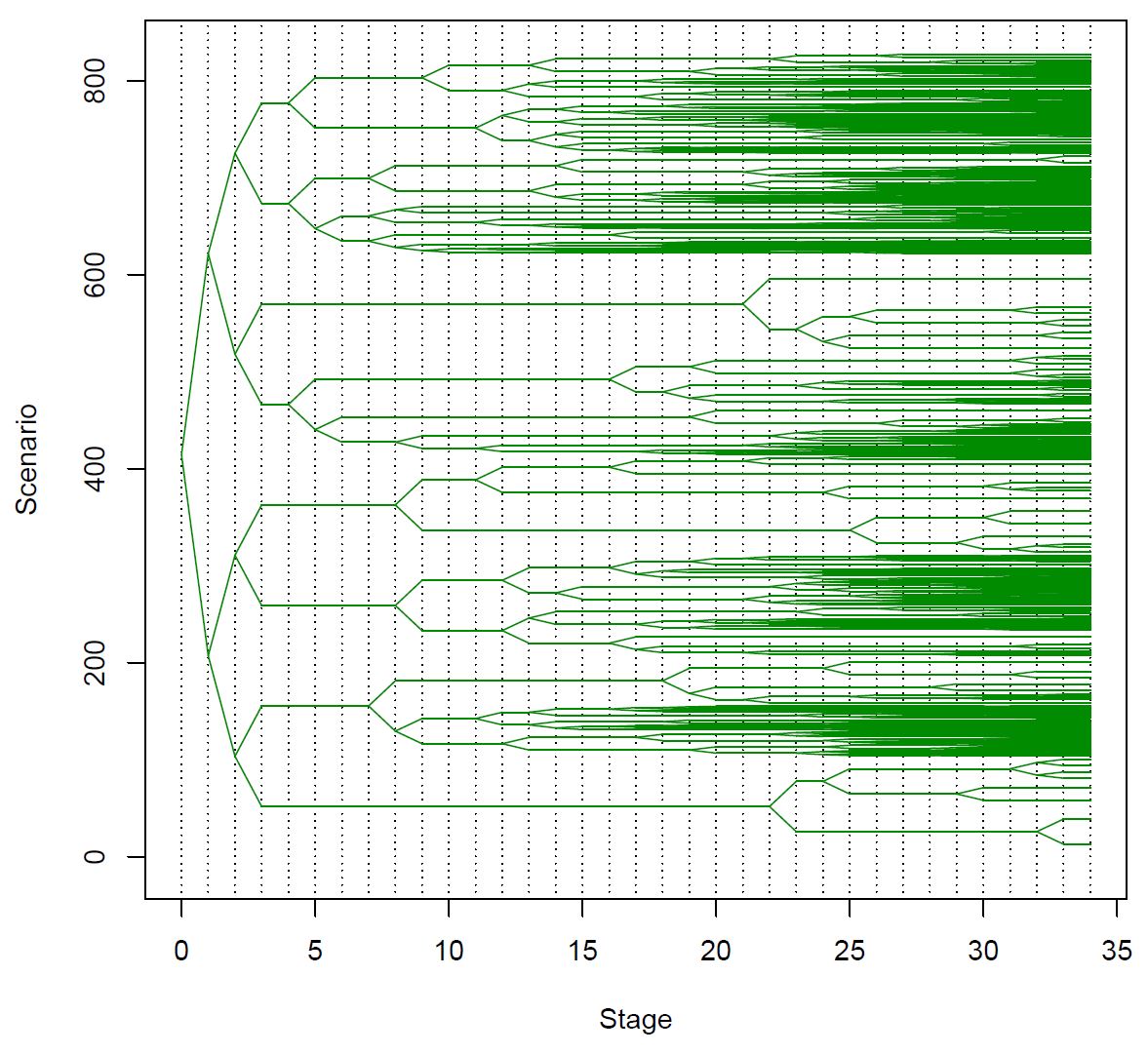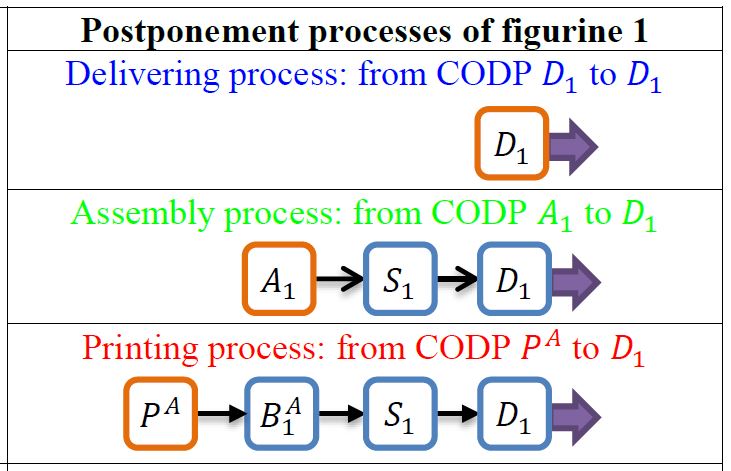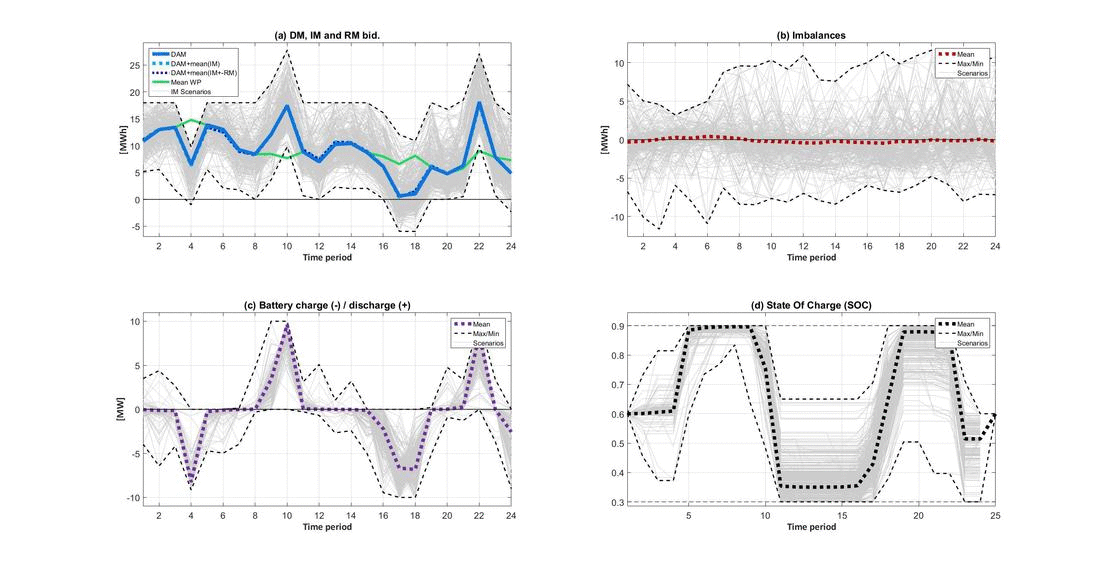stochastic programming
Speculation – postponement strategies in supply chain network design problems: a modelling framework for new supply chain strategies through stochastic optimization
Thu, 10/24/2024 - 12:05 — admin| Publication Type | Thesis |
| Year of Publication | 2024 |
| Authors | Daniel Ramón Lumbierres |
| Academic Department | Dept. Statistics and Operations Research |
| Number of Pages | 124 |
| University | Universitat Politècnica de Catalunya |
| City | Barcelona |
| Degree | PhD Thesis |
| Key Words | supply chain; postponement; stochastic programming; research |
| Abstract | Speculation i Postponement son estratègies oposades de cadena de subministrament dirigides a avançar o postposar els processos de producción que transformen matèries primeres en productes acabats. Un Punt de Desacoblament d’Ordres de Consumidor, o CODP, és un punt logístic de la cadena on la producció especulativa és emmagatzemada fins a l’arribada d’ordres de demanda, de manera que el posicionament de CODPs caracteritza l’estratègia associada a la cadena de subministrament. Es presenten dos models d’optimització per decidir el Disseny en Xarxa de Cadena de Subministrament òptim i la seva estrategia Speculation – Postponement associada mitjançant un enfoc d’optimització estocástica en dues etapes: el primer model, anomenat ( |
| URL | Click Here |
| Export | Tagged XML BibTex |
Multistage Scenario Trees Generation for Electricity Markets Optimization
Tue, 07/13/2021 - 10:51 — admin| Publication Type | Conference Paper |
| Year of Publication | 2021 |
| Authors | Marlyn Dayana Cuadrado Guevara; F.-Javier Heredia |
| Conference Name | 31st European Conference on Operational Research. |
| Conference Date | 11-14/07/2021 |
| Conference Location | Athens |
| Type of Work | Invited presentation |
| ISBN Number | ISBN 978-618-85079-1-3 |
| Key Words | research; multistage stochastich programming; virtual power plants; electricity markets; scenarios tree generation |
| Abstract | The presence of renewables in electricity markets optimization have generated a high level of uncertainty in the data, which has led to a need for applying stochastic optimization to model this kind of problems. In this work, we apply Multistage Stochastic Programming (MSP) using scenario trees to represent energy prices and wind power generation. We developed a methodology of two phases where, in the first phase, a procedure to predict the next day for each random parameter of the MSP models is used, and, in the second phase, a set of scenario trees are built through Forward Tree Construction Algorithm (FTCA) and a modified Dynamic Tree Generation with a Flexible Bushiness Algorithm (DTGFBA). This methodology was used to generate scenario trees for the Multistage Stochastic Wind Battery Virtual Power Plant model (MSWBVPP model), which were based on MIBEL prices and wind power generation of a real wind farm in Spain. In addition, we solved three di erent case studies corresponding to three di erent hypotheses on the virtual power plant’s participation in electricity markets. Finally, we study the relative performance of the FTCA and DTGFBA scenario trees, analysing the value of the stochastic solution through the Forecasted Value of the Stochastic Solution (FVSS) and the classical VSS for the 366 daily instances of the MSWBVPP problem spanning a complete year. |
| URL | Click Here |
| Export | Tagged XML BibTex |
Ph D. Thesis on multistage scenario tree generation for renewable energies.
Mon, 11/30/2020 - 19:40 — admin On November 30th 2020 took place the defense of the Ph.D. Thesis entittled "Multistage Scenario Trees Generation for Renewable Energy Systems Optimization", authored by Ms. Marlyn D. Cuadrado Guevara and advised by prof. F.-Javier Heredia. In this thesis a new methodology to generate and validate probability scenario trees for multistage stochastic programming problems arising in two different energy systems with renewables are proposed. The first problem corresponds to the optimal bid to electricity markets of a virtual power plant that consists on a wind-power plant plus a battery storage energy systems. The second one is the optimal operation of a distribution grid with some photovoltaic production.
On November 30th 2020 took place the defense of the Ph.D. Thesis entittled "Multistage Scenario Trees Generation for Renewable Energy Systems Optimization", authored by Ms. Marlyn D. Cuadrado Guevara and advised by prof. F.-Javier Heredia. In this thesis a new methodology to generate and validate probability scenario trees for multistage stochastic programming problems arising in two different energy systems with renewables are proposed. The first problem corresponds to the optimal bid to electricity markets of a virtual power plant that consists on a wind-power plant plus a battery storage energy systems. The second one is the optimal operation of a distribution grid with some photovoltaic production.
Multistage Scenario Trees Generation for Renewable Energy Systems Optimization
Mon, 11/30/2020 - 19:17 — admin| Publication Type | Thesis |
| Year of Publication | 2020 |
| Authors | Marlyn Dayana Cuadrado Guevara |
| Academic Department | Dept. of Statistics and Operations Research. Prof. F.-Javier Heredia, advisor. |
| Number of Pages | 194 |
| University | Universitat Politècnica de Catalunya |
| City | Barcelona |
| Degree | PhD Thesis |
| Key Words | research; Battery energy storage systems; Electricity markets; Ancillary services market; Wind power generation; Virtual power plants; Multistage Stochastic programming; phd thesis |
| Abstract | The presence of renewables in energy systems optimization have generated a high level of uncertainty in the data, which has led to a need for applying stochastic optimization to modelling problems with this characteristic. The method followed in this thesis is Multistage Stochastic Programming (MSP). Central to MSP is the idea of representing uncertainty (which, in this case, is modelled with a stochastic process) using scenario trees. In this thesis, we developed a methodology that starts with available historical data; generates a set of scenarios for each random variable of the MSP model; defines individual scenarios that are used to build the initial stochastic process (as a fan or an initial scenario tree); and builds the final scenario trees that are the approximation of the stochastic process. |
| URL | Click Here |
| Export | Tagged XML BibTex |
New paper published in International Journal of Production Research.
Tue, 07/21/2020 - 16:46 — admin The paper entitled Optimal Postponement in Supply Chain Network Design Under Uncertainty: An Application for Additive Manufacturing (preprint ) has been published in the International Journal of Production Research. This paper is the result of projects Strategical Models in Supply Chain Design, and Digitalizing Supply Chain Strategy with 3D Printing a successful collaboration between GNOM with Accenture Technology Labs (Silicon Valley), Accenture Analytics Innovation Center (Barcelona) and the Fundació CIM-UPC. This study This study presents a new two-stage stochastic programming decision model for assessing how to introduce some new manufacturing technology into any generic supply and distribution chain. It additionally determines the optimal degree of postponement, as represented by the so-called customer order decoupling point (CODP), while assuming uncertainty in demand for multiple products. Finally, it presents and analyses a case study for introducing additive manufacturing technologies.
The paper entitled Optimal Postponement in Supply Chain Network Design Under Uncertainty: An Application for Additive Manufacturing (preprint ) has been published in the International Journal of Production Research. This paper is the result of projects Strategical Models in Supply Chain Design, and Digitalizing Supply Chain Strategy with 3D Printing a successful collaboration between GNOM with Accenture Technology Labs (Silicon Valley), Accenture Analytics Innovation Center (Barcelona) and the Fundació CIM-UPC. This study This study presents a new two-stage stochastic programming decision model for assessing how to introduce some new manufacturing technology into any generic supply and distribution chain. It additionally determines the optimal degree of postponement, as represented by the so-called customer order decoupling point (CODP), while assuming uncertainty in demand for multiple products. Finally, it presents and analyses a case study for introducing additive manufacturing technologies.
Optimal Postponement in Supply Chain Network Design Under Uncertainty: An Application for Additive Manufacturing
Tue, 07/21/2020 - 15:49 — admin| Publication Type | Journal Article |
| Year of Publication | 2021 |
| Authors | Daniel Ramón-Lumbierres; F.-Javier Heredia; Joaquim Minguella-Canela; Asier Muguruza-Blanco |
| Journal Title | International Journal of Production Research |
| Pages | 5198-5215 |
| Journal Date | 07/2020 |
| Publisher | Taylor&Francis |
| ISSN Number | 0020-7543 |
| Key Words | manufacturing; postponement; stochastic programming; supply chain network design; 3D printing; additive manufacturing; research; paper |
| Abstract | This study presents a new two-stage stochastic programming decision model for assessing how to introduce some new manufacturing technology into any generic supply and distribution chain. It additionally determines the optimal degree of postponement, as represented by the so-called customer order decoupling point (CODP), while assuming uncertainty in demand for multiple products. To this end, we propose here the formulation of a generic supply chain through an oriented graph that represents all the deployable alternative technologies, which are defined through a set of operations that are characterized by lead times and cost parameters. Based on this graph, we develop a mixed integer two-stage stochastic program that finds the optimal manufacturing technology for meeting each market’s demand, each operation’s optimal production quantity, and each selected technology’s optimal CODP. We also present and analyse a case study for introducing additive manufacturing technologies. |
| URL | Click Here |
| DOI | 10.1080/00207543.2020.1775908 |
| Preprint | http://hdl.handle.net/2117/327874 |
| Export | Tagged XML BibTex |
A Multistage Stochastic Programming Model for the Optimal Bid of Wind-BESS Virtual Power Plants to Electricity Markets
Sat, 12/16/2017 - 00:00 — admin| Publication Type | Conference Paper |
| Year of Publication | 2017 |
| Authors | F.-Javier Heredia; Marlyn D. Cuadrado; J.-Anton Sánchez |
| Conference Name | 4th International Conference on Optimization Methods and Software 2017 |
| Conference Date | 16-21/12/2017 |
| Conference Location | La Havana |
| Type of Work | Invited presentation |
| Key Words | multistage; VSS; wind-BESS VPP; wind power; energy storage; battery; research |
| Abstract | One of the objectives of the FOWGEN project (https://fowgem.upc.edu) was to study the economic feasibility and optimal operation of a wind-BESS Virtual Power Plant (VPP): In [1] an ex-post economic analysis shows the economic viability of a wind-BESS VPP thanks to the optimal operation in day-ahead and ancillary electricity markets; In [2] a new multi-stage stochastic programming model (WBVPP)for the optimal bid of a wind producer both in spot and ancillary services electricity markets is developed. The work presented here extends the study in [2] with a new methodology to treat the uncertainty, based in forecasting models, and the study of the quality of the stochastic solution. [1] F-Javier Heredia et al. Economic analysis of battery electric storage systems operating in electricity markets 12th International Conference on the European Energy Market (EEM15), 2015 DOI: 10.1109/EEM.2015.7216739. [2] F-Javier Heredia et al. On optimal participation in the electricity markets of wind power plants with battery energy storage system. Submitted, under second revision. 2017. |
| URL | Click Here |
| Export | Tagged XML BibTex |
Contribution to the 4th International Conference on Optimization Methods and Software 2017, La Havana.
Sat, 12/16/2017 - 00:00 — admin
 Last december I was invited to the 4th International Conference on Optimization Methods and Software 2017 that was held in La Havana, to present the study A Multistage Stochastic Programming Model for the Optimal Bid of Wind-BESS Virtual Power Plants to Electricity Markets. This study was developed in collaboration with Marlyn Cuadrado and Josep Anton Sánchez, from my same department in the UPC, and is a partial result of the research project FOWGEM. This study is a follow up of the previous work presented in the WindFarms 2017 Conference extended with a new methodology to treat the uncertainty, based in forecasting models, and the study of the quality of the stochastic solution through the Value of the Stochastic Solution. In the animated graph you can observe how the the probability distribution of several recourse variables (optimal bid, imbalances, charge/discharge and SOC) evolves along five working days.
Last december I was invited to the 4th International Conference on Optimization Methods and Software 2017 that was held in La Havana, to present the study A Multistage Stochastic Programming Model for the Optimal Bid of Wind-BESS Virtual Power Plants to Electricity Markets. This study was developed in collaboration with Marlyn Cuadrado and Josep Anton Sánchez, from my same department in the UPC, and is a partial result of the research project FOWGEM. This study is a follow up of the previous work presented in the WindFarms 2017 Conference extended with a new methodology to treat the uncertainty, based in forecasting models, and the study of the quality of the stochastic solution through the Value of the Stochastic Solution. In the animated graph you can observe how the the probability distribution of several recourse variables (optimal bid, imbalances, charge/discharge and SOC) evolves along five working days.
Optimal Supply Chain Strategy through Stochastic Programming
Mon, 07/18/2016 - 19:11 — admin| Publication Type | Tesis de Grau i Màster // BSc and MSc Thesis |
| Year of Publication | 2016 |
| Authors | Daniel Ramon Lumbierres |
| Director | F.-Javier Heredia |
| Tipus de tesi | MSc Thesis |
| Titulació | Master in Statistics and Operations Research |
| Centre | Faculty of Mathematics and Statistics |
| Data defensa | 27/07/2016 |
| Nota // mark | 9.5 Excel·lent MH (A+ with Honors) |
| Key Words | teaching; supply chain; 3D printing; Postponment; stochastic programming; Accenture; MSc Thesis |
| Abstract | In this project, a new two-stage stochastic programming decision model has been developed to assess: (a) the convenience of introducing 3D printing into any generic manufacturing process, both single and multi-product; and (b) the optimal degree of postponement known as the customer order decoupling point (CODP) while also assuming uncertainty in demand for multiple markets. To this end, we propose the formulation of a generic supply chain through an oriented graph that represents all the deployable alternative technologies. These are defined through a set of operations for manufacturing, assembly and distribution, each of which is characterized by a lead time and cost parameters. Based on this graph, we develop a mixed integer two-stage stochastic program that finds the optimal manufacturing technology to meet the demand of each market, the optimal production quantity for each operation, and the optimal CODP for each technology. The results obtained from several case studies in real manufacturing companies are presented and analyzed. The work presented in this master’s thesis is part of an ongoing research project between UPC and Accenture. |
| DOI / handle | http://hdl.handle.net/2117/88818 |
| URL | Click Here |
| Export | Tagged XML BibTex |
Optimal Supply Chain Strategy and Postponement Degree with 3D Printing
Mon, 07/18/2016 - 19:04 — admin| Publication Type | Conference Paper |
| Year of Publication | 2016 |
| Authors | Daniel Ramon Lumbierres; Asier Muguruza; Robert Gimeno Feu; Ping Guo; Mary Hamilton; Kiron Shastry; Sunny Webb; Joaquim Minguella; F.-Javier Heredia |
| Conference Name | 28th European Conference on Operational Research |
| Series Title | Conference Handbook |
| Pagination | 330 |
| Conference Date | 3-6/07/2016 |
| Conference Location | Poznan, Poland |
| Type of Work | contributed presentation. |
| Key Words | research; supply chain; 3D printing; stochastic programming; postponment; modeling; additive manufacturing |
| Abstract | In this contribution we would like to present the results of a research project developed by Accenture and BarcelonaTech aiming at studying the advantages of ultra-postponement with 3D printing using the analytical tools of operational research. In this project a new two-stage stochastic programming decision model has been developed to assess (a) the convenience of the introduction of 3D printing in any generic supply chain and (b) the optimal degree of postponement, the so called Customer Order Decoupling Point (CODP), assuming uncertainty in demand for multiple markets. To this end we propose the formulation of a generic supply chain through an oriented graph that represents all the alternative technologies that can be deployed, defined through a set of operations for manufacturing, assembly and distribution, each one characterized by a lead time and cost parameters. Based on this graph we develop a mixed integer two-stage stochastic program that finds the optimal manufacturing technology to meet the demand of each market, the optimal production quantity for each operation and the optimal CODP for each technology. The results obtained with several case studies from real manufacturing companies are presented and analyzed. |
| URL | Click Here |
| Export | Tagged XML BibTex |
